

at home amongst the gum trees
The open eucalypt woodland here with its red gum and coolibah trees provides a wonderful resource for bush birds. The hollows that naturally occur the older trees are especially valuable as nesting sites.
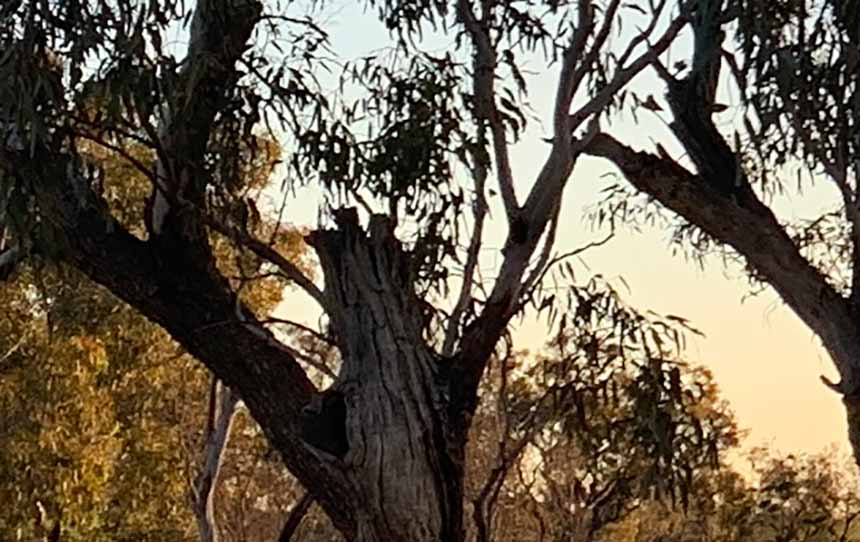
Then there are the lerps – the tiny 5mm wide, pointy hat looking, sap sucking insects that plague the trees. These are basically pure starch with some proteins and fats.

Lerps are a favourite food for birds such as pardalotes, honeyeaters, friarbirds, whistlers and thornbills. Listen out for these bush songbirds as you walk along the path here. Look up into the canopy to see if you can spot any of these foragers at work.
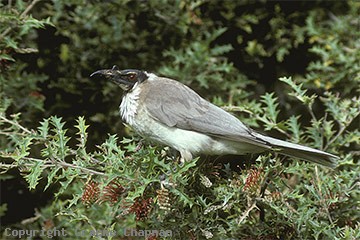

Noisy Friarbird
Philemon corniculatus
Noisy Friarbirds are conspicuous and active honeyeaters which are active in the outer canopy of flowering trees, especially eucalypts. They clamber about among the foliage, probing the flowers to feed on nectar, as well as gleaning lerps and manna. They also sally after flying insects. Friarbirds often associate with other larger honeyeaters such as wattlebirds, but may exclude smaller birds from profusely flowering trees. The Noisy Friarbird has a characteristically bare black head, and for this reason the species is occasionally referred to as a ‘leatherhead’.
Photo, audio: Graeme Chapman Text: birdlife.org.au


Grey Shrike-thrush
Colluricincla harmonica
All four species of shrike-thrush in Australia are amongst our sweetest songsters and the Grey is no exception. Grey Shrike-thrushes are the most widespread and, except for the most arid deserts and in deep rainforest, are found all over Australia and Tasmania as well as the offshore islands. There are three subspecies within Australia, basically eastern, northern and western. Birds from south-western Australia are the most distinctive of these because of their pale-rufous undertail coverts.
Photo, text, audio: Graeme Chapman
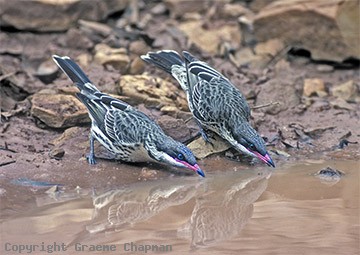

Spiny-cheeked Honeyeater
Colluricincla harmonica
Spiny-cheeked Honeyeaters are the common, large honeyeaters of the inland where they occupy the niche held in more coastal regions by the wattlebirds. Once adult, they live as pairs in permanent territories although they may congregate in small flocks at rich food sources in dry times. They feed largely on small fruits and berries and arthropods but nectar is also eaten when available. Their musical piping calls are a common early morning sound in the inland. Males also fly vertically in a short display flight to advertise territory ownership.
Photo, text, audio: Graeme Chapman
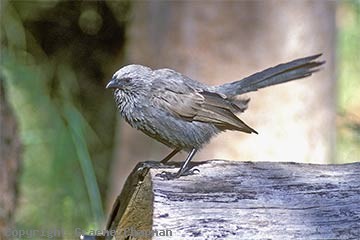

Apostlebird
Struthidea cinerea
Apostlebirds are very sociable and most of the time live in family groups which occasionally reach twelve or more in number, hence their common name. The family group usually consists of a dominant male and female together with the progeny from recent nestings. It takes three to four years for birds to become adult.In the breeding season, Apostlebirds occupy much the same territories year after year, but in winter in drier inland areas family groups may congregate at a suitable food source to form loose flocks of a hundred or so. Noisy and active, they are familiar birds around homesteads and freely associate with humans. They feed almost entirely on the ground keeping loosely together as a group and visit a water source daily. The stout, but still quite curved bill is well adapted to seed eating, a useful attribute in harsh inland winters.
Photo, text, audio: Graeme Chapman


Chestnut-crowned Babbler
Pomatostomus ruficeps
"You often see these birds hopping and bouncing in follow the leader fashion over the ground in more open situations - that's probably because they mainly inhabit the arid zone where there is more open ground! In the east, you have to go as far west as Cunnamulla or Cobar before you'll find them - in Victoria they only just make it into the north-west corner and up along the Murray River a little - in S.A. you have to go north-east or north of the Flinders Ranges. They don't occur in either the N.T. or W.A. Like the other babblers, they live communally in family groups, up to 20 or so at times and build huge stick nests, both for roosting and for nesting. I photographed these birds at Lake Bindegolly near Thargomindah in Queensland where they are easy to observe in the low shrubland around the edge of the lake. Another good place to see them is a bit further on at Kilcowera Station SE of Thargomindah where the camping and facilities are excellent."
Photo, text, audio: Graeme Chapman
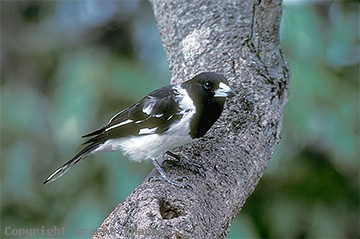

Pied Butcherbird
Cracticus nigrogularis
Pied Butcherbirds occur virtually all over Australia except for southern South Australia and Victoria.The most sociable of all the butcherbirds, Pied Butcherbirds occupy permanent territories and live as families, usually between three to five birds made up of the adult pair and progeny from previous nestings. Usually, at least one of these immatures is in brown plumage which persists for the first eighteen months or so. In built-up areas, Pied Butcherbirds are quick to take advantage of handouts and many people do feed them, but a word of warning! they can become a nuisance and sit half the day on your kitchen windowsill, demanding food. Pied Butcherbirds live in more open country than Grey Butcherbirds and have benefited from the expansion of farming.
Photo, text, audio: Graeme Chapman


Chrimson Chat
Epthianura tricolor
The Crimson Chat is one of our classic arid-zone nomads. Normally found in the dry savannahs and deserts of the inland, during extremes of climate they occasionally irrupt into more open country nearer the coast. In southern Australia Crimson Chats are migratory and in places that have experienced good winter rains they arrive in late winter and settle down to breed. On migration they travel in flocks and when breeding, may form loose colonies, each pair maintaining a small territory around the nest. They feed mainly on the ground where they busily search for arthropods, occasionally reaching into flowers on low-growing shrubs for nectar for which their brush-tipped tongues are ideally adapted. The brilliant crimson colour of the males is a breeding plumage only adopted in summer - on their return to northern Australia the following year, they moult again into a plainer brown winter plumage.
Photo, text, audio: Graeme Chapman
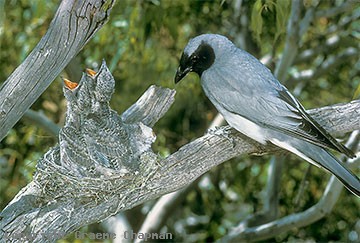

Black-faced Cuckoo-shrike
Coracina novaehollandiae
Black-faced Cuckoo-shrikes are one of our most common birds and are found virtually everywhere in Australia except in rainforest or out on treeless plains. Other popular names include Blue Jay (a misnomer, there are no Jays in Australia) or Shufflewing, a very apt alternative derived from their distinctive habit of shuffling each wing alternately on alighting. Adults breed as pairs in territories but there are odd records of more than two birds attending a nest. In some areas territories are permanent but in cooler more southern regions they may be vacated in winter. Some movement does occur and flocks of up to 150 birds have been recorded. Black-faced Cuckoo-shrikes feed on invertebrates both in the air and on the ground. They also glean food (which may include small fruit) from foliage and are quite adept at doing this in flight. I have seen them taking mulberries on the wing. They build quite a small nest in a fairly thick horizontal fork, usually in a eucalypt at 10 or so metres from the ground.(see 424002) The nest is usually quite hard to see from below. When the nestlings approach fledging, there is barely enough room for them and they have to cling onto the nest, rather than sit in it. Occasionally, one does fall out to the ground.
Photo, text, audio: Graeme Chapman
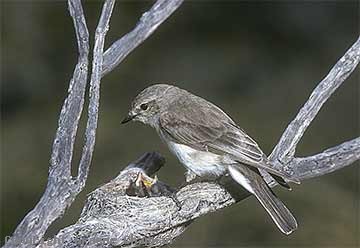

Jacky Winter
Microeca fascinans
The name Jacky Winter probably originated in rural Victoria back in the early 1900s; until then they were generally known as Brown Flycatcher but in 1926 the name Jacky Winter became officially accepted. Jacky Winters are amongst the plainest coloured birds in Australia, their main distinguishing feature being white outer tail feathers which are only clearly visible in flight. Adult Jacky Winters usually live in pairs and are generally regarded as being sedentary, occupying territories of 10 - 15 Ha. They inhabit open woodland and semi-arid shrubland and have adapted well to farming and grazing lands. They rarely occur in closed or wet forest and never in rainforest. You see them typically as single birds, out on an exposed perch such as a dead branch or fencepost, perhaps twisting the tail from side to side whilst on the lookout for their food which they snatch from both in the air or from the ground. The female alone builds the very small nest and incubates the two or three eggs but the male helps to feed the young - there is at least one record of a third bird helping at the nest but this is unusual. Jacky Winters have an attractive song which is mostly given from an outstanding perch, but sometimes also in a flight display. The simple song is a repeated two note phrase, likened by some people to "Peter - Peter - Peter", but it can also be more varied and complex. They are excellent mimics.
Photo, text, audio: Graeme Chapman

Photo, text, audio: Graeme Chapman
Sacred Kingfisher
Todiramphus sanctus
The Sacred Kingfisher is probably our most common small kingfisher. They occur all over Australia except for the desert regions devoid of trees. In southern Australia, Sacred Kingfishers are migrants, arriving in Spring and departing the following March for northern Australia and sometimes beyond. Favourite nest sites are arboreal termite mounds into which they drill a short nest tunnel but they also use existing hollows in trees. Usually these nest sites are well off the ground (5 - 15m) where they are safer from marauding goannas which occasionally prey on the nests. On rare occasions they tunnel into an earthen bank, usually a high one for the same reason. Sacred Kingfishers feed mainly over the land on insects and small reptiles but they will take fish and yabbies from water such as garden ponds where available. They vary a bit in colour - the ochraceous underparts gradually wear through the season to a dull off-white colour.
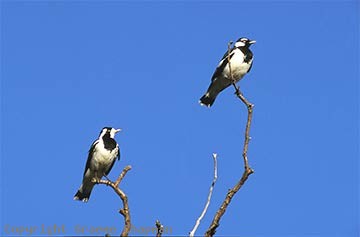
Photo, text, audio: Graeme Chapman
Magpie Lark
Todiramphus sanctus
The Magpie-lark is one of our most familiar common birds - it occurs over most of Australia and in all of our capital cities (except Hobart) where it is variously known as Peewee, Peewit, Mudlark or Murray Magpie. The name Peewee derives from the loud distinctive call. Very often a pair will stand on a rooftop or telephone pole and loudly proclaim their territory. The song is sung alternately by each bird (called antiphonal singing) and each "peewee" phrase is accompanied by lifting and opening the wings, known as "flag display". Their liking for feeding along the edges of or in shallow water betrays their close relationship to the Torrent Lark of New Guinea which, as its name suggests, frequents small flowing streams.
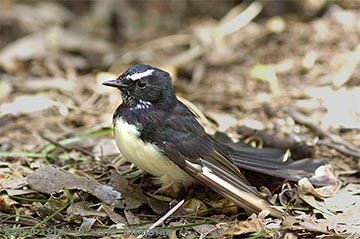
Photo,audio: Graeme Chapman Text: birdlife.org.au
Willie Wagtail
Rhipidura leucophrys
The Willie Wagtail is the largest, and most well-known, of the Australian fantails. The plumage is black above with a white belly. The Willie Wagtail can be distinguished from other similar-sized black and white birds by its black throat and white eyebrows and whisker marks. The name wagtail stems from the constant sideways wagging of the tail. Young birds resemble the adults, but have paler, slightly rusty edges to the feathers of the wings. The Willie Wagtail is one of Australia's most widespread species, at least on the mainland. Reflecting this, it features prominently in Indigenous mythology. Willie Wagtails were disliked by Indigenous people in some areas, as they were thought to loiter at the edge of camps, listening to conversations then telling the secrets elsewhere. The Willie Wagtail was also seen as an ill omen, and they would abandon an expedition if a Willie Wagtail was seen on the morning of departure.
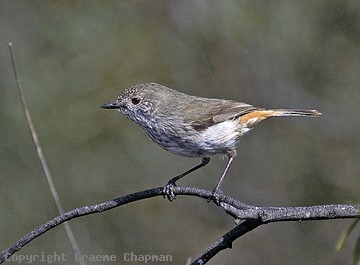
Photo, audio: Graeme Chapman Text: Wikipedia
Inland Thornbill
Rhipidura leucophrys
The Inland Thornbill can be found throughout Australia inland of the Great Dividing Range, but not in tropical northern climates or in Tasmania. The inland thornbill overlaps in range with the brown thornbill along the Great Dividing Range, leading to numerous mis-sightings.Inland thornbills live in dry scrublands and woodlands. In Southwestern Australia, they also inhabit sand heaths and karri and jarrah forests. It feeds on small insects and spiders, and occasionally seeds and small vegetable matter, beneath shrubs and in foliage.

4. Blacksoil
6. Mitchell Grass
